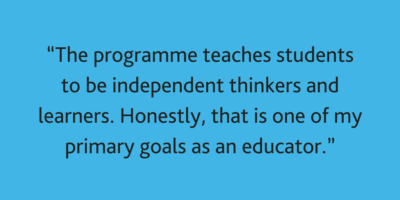It’s a really exciting time to be launching a skills-based programme for schools to deliver. From the BBC to the OECD to the UN, the hot education topic for the last few years has been transferable skills and the need for schools to get students college- and work-ready.
At Cambridge International, we’ve already met this demand for older learners with our Cambridge IGCSE and Cambridge International A Level Cambridge Global Perspectives courses. But we’ve also been working behind the scenes on a skills-based programme for primary and lower secondary learners – and it’s now available to schools worldwide. From June of this year, schools will able to offer Cambridge Global Perspectives to learners at every stage of the Cambridge Pathway from age 5 to 19.
I’ve spent the last two years working with a group of passionate and engaged teachers from all over the world as they trialled Cambridge Global Perspectives with their 5 to 14 year olds. Here’s some of their advice on how to introduce the programme effectively.
Take your time
Timetabling a new programme has practical implications. No matter how enthusiastic and motivated you are, school timetables are already full. Cambridge Primary and Lower Secondary Global Perspectives has been designed to be offered flexibly so that schools can implement it in the way that suits them. There’s no need to offer the whole programme from day one. Concentrate on one skill to start with, or pick topics that are familiar. Try out different ways of delivering it: collapsed timetable, as a study /library skills lesson, in a specific subject lesson, or use different options for different year groups to see what works. The important point is to use the flexibility and introduce it thoughtfully, at a pace that suits your setting.

Encourage teacher collaboration
Cambridge Global Perspectives is not tied to a specific subject. Its cross-curricular approach means the materials can be delivered by looking at the topic through any subject lens, from writing for a particular audience in English, to analysing and interpreting graphs in mathematics and science, to evaluating news sources in history. One teacher commented that they when they introduced the programme to the teachers in their school:
“The course allowed for collaboration among teachers in bringing new ideas in terms of activities, discussing the local and national environment of the child and in planning relevant field trips”
The result can make a much more engaging teacher experience: “The teachers bring other points of view and a different, more educated and creative way to plan their lessons.”

Engage your stakeholders
As well as the skills the programme develops (which you can read about here), our pilot teachers told us that teachers and parents become engaged in the programme when they understand how it also supports important study skills like public speaking, conducting effective research and academic honesty.
For teachers, it’s useful to make the commitment and expectations of the workload clear. They also need reassurance about delivering the programme. One pilot teacher told me ‘I started off being very sceptical but have grown more and more enthusiastic… I actually do quite a lot of this already in my classes.’
Pilot schools also recommend introducing parent information sessions using weekly drop ins, end of term presentations and even occasionally involving parents in the programme lessons.
And as you ponder whether to introduce the programme at your school, these words from a teacher in the USA sum up nicely why you should: “The programme teaches students to be independent thinkers and learners. Honestly, that is one of my primary goals as an educator.”
I hope that this gives you some ideas that you can discuss and debate with your colleagues.
Thanks to all our fantastic schools who took part in this pilot. More details of the programme are available from our website – search for Cambridge Global Perspectives, or contact your regional rep.





